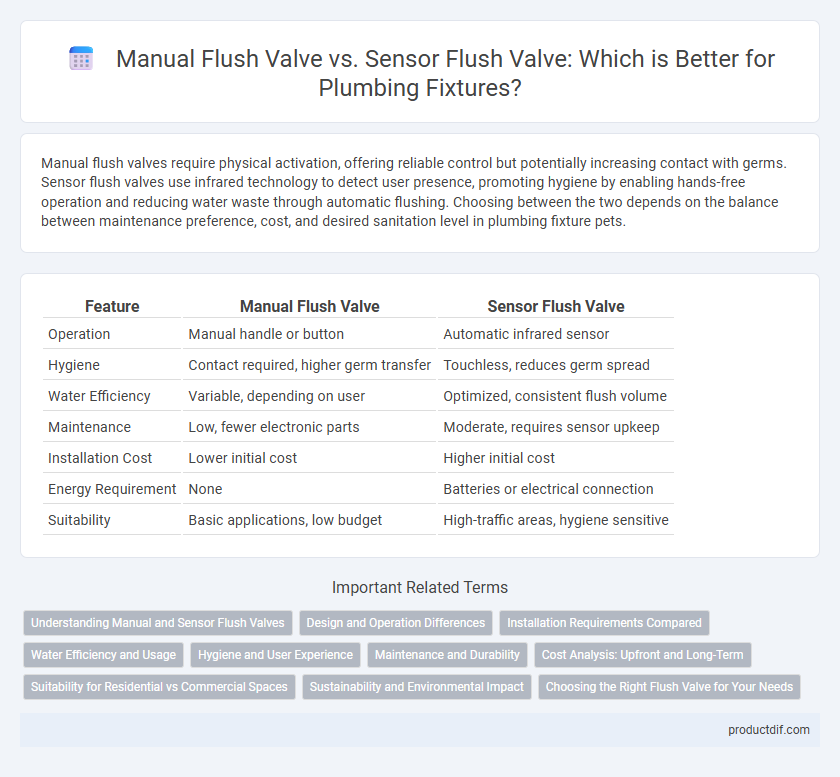Manual flush valves require physical activation, offering reliable control but potentially increasing contact with germs. Sensor flush valves use infrared technology to detect user presence, promoting hygiene by enabling hands-free operation and reducing water waste through automatic flushing. Choosing between the two depends on the balance between maintenance preference, cost, and desired sanitation level in plumbing fixture pets.
Table of Comparison
| Feature | Manual Flush Valve | Sensor Flush Valve |
|---|---|---|
| Operation | Manual handle or button | Automatic infrared sensor |
| Hygiene | Contact required, higher germ transfer | Touchless, reduces germ spread |
| Water Efficiency | Variable, depending on user | Optimized, consistent flush volume |
| Maintenance | Low, fewer electronic parts | Moderate, requires sensor upkeep |
| Installation Cost | Lower initial cost | Higher initial cost |
| Energy Requirement | None | Batteries or electrical connection |
| Suitability | Basic applications, low budget | High-traffic areas, hygiene sensitive |
Understanding Manual and Sensor Flush Valves
Manual flush valves operate through direct user activation, requiring physical contact to initiate water flow, which can increase the risk of germ transmission in public restrooms. Sensor flush valves utilize infrared technology to detect user presence and automatically trigger flushing, promoting enhanced hygiene and water efficiency. Understanding the differences between these valves is critical for selecting suitable plumbing fixtures that balance maintenance needs, user convenience, and sanitation standards.
Design and Operation Differences
Manual flush valves use a lever or button activated by hand pressure to release water, enabling direct user control over flush duration and volume. Sensor flush valves employ infrared or capacitive sensors to detect user presence, triggering automatic flushing without physical contact and enhancing hygiene. The design of manual valves is simpler and more mechanical, while sensor valves integrate electronic components and require power sources for operation.
Installation Requirements Compared
Manual flush valves require straightforward installation with basic plumbing connections and a handle or button for operation, making them compatible with most restroom setups and requiring less initial adjustment. Sensor flush valves demand more complex installation, including electrical wiring or batteries, placement of sensors at optimal angles, and sometimes integration with existing water supply systems, resulting in higher upfront costs and longer setup times. Plumbing professionals must consider these factors, along with maintenance accessibility, when choosing between manual and sensor flush valves for commercial or residential applications.
Water Efficiency and Usage
Manual flush valves consume a fixed amount of water with each flush, often leading to overuse and higher water bills in busy restrooms. Sensor flush valves automatically regulate water flow based on usage, reducing water waste by controlling flush volume and frequency. This technology can lower water consumption by up to 30%, making sensor flush valves a more efficient and eco-friendly choice for commercial and public facilities.
Hygiene and User Experience
Manual flush valves require physical contact, increasing the risk of germ transmission and reducing hygiene, while sensor flush valves offer a touchless operation that significantly enhances sanitation. Sensor flush valves provide a more convenient and efficient user experience by automatically flushing after use, minimizing water waste and maintenance needs. The integration of infrared or capacitive sensors in sensor flush valves ensures reliable activation and improved restroom cleanliness, making them the preferred choice for high-traffic or hygiene-sensitive environments.
Maintenance and Durability
Manual flush valves require regular maintenance due to mechanical wear from frequent handling, often leading to gasket and diaphragm replacements. Sensor flush valves offer enhanced durability with fewer moving parts, reducing maintenance frequency and minimizing potential leaks. However, sensor valves depend on electronic components that may require periodic battery replacement and sensor calibration.
Cost Analysis: Upfront and Long-Term
Manual flush valves typically have a lower upfront cost, making them more budget-friendly for initial installation. Sensor flush valves incur higher installation expenses but can reduce water consumption significantly, leading to long-term savings on utility bills. Maintenance costs for sensor valves may be higher due to electronic components, while manual valves require less specialized upkeep.
Suitability for Residential vs Commercial Spaces
Manual flush valves offer reliable control and are often preferred in residential settings due to simplicity and cost-effectiveness. Sensor flush valves enhance hygiene and water efficiency, making them ideal for high-traffic commercial spaces like office buildings, malls, and airports. Choosing between manual and sensor flush valves depends on user convenience, maintenance considerations, and frequency of use in the specific environment.
Sustainability and Environmental Impact
Manual flush valves typically consume more water due to inconsistent user operation, leading to higher water waste compared to sensor flush valves. Sensor flush valves enhance sustainability by controlling flush volume automatically, reducing unnecessary water usage and conserving resources. Implementing sensor technology in plumbing fixtures significantly lowers environmental impact through efficient water management and reduced overall consumption.
Choosing the Right Flush Valve for Your Needs
Choosing the right flush valve depends on usage patterns and maintenance preferences; manual flush valves offer reliability and simplicity with fewer mechanical failures, ideal for high-traffic areas with straightforward operation. Sensor flush valves provide touch-free convenience and improved hygiene by reducing contact points, making them suitable for public restrooms prioritizing sanitation and water efficiency. Evaluate factors such as installation costs, water savings, and user experience to make an informed decision tailored to your facility's needs.
Manual flush valve vs Sensor flush valve Infographic

 productdif.com
productdif.com